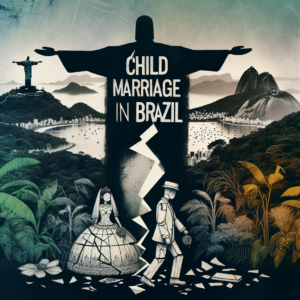Understanding the Harsh Reality: Child Marriage and Its Consequences
Introduction:
Child marriage is a global issue that has devastating consequences for millions of children, particularly young girls, all around the world. It refers to the marriage of individuals below the legal age of consent, which is 18 years in most countries. This harmful practice has numerous negative consequences, including violation of human rights, physical and psychological health risks, and hindrance to personal and societal development. This article aims to shed light on the harsh reality of child marriage and its long-lasting effects on the lives of those involved.
Defining Child Marriage:
Child marriage is a prevalent problem that affects both boys and girls, but young girls are disproportionately the victims. According to UNICEF, every year, approximately 12 million girls worldwide are married before they reach the age of 18. This means that every two seconds, a girl becomes a child bride. Child marriage is deeply rooted in cultural, economic, and social norms, often perpetuated by poverty, gender inequality, and traditions. However, it is essential to recognize that child marriage is a human rights violation and should be viewed as such, regardless of any cultural justification.
Consequences of Child Marriage:
1. Limited Education Opportunities:
Child marriage disrupts the education of young girls, depriving them of the chance to develop their skills and knowledge. Early marriage often leads to early pregnancy, making it challenging for girls to continue their education. This lack of education perpetuates the cycle of poverty and limits their potential to contribute positively to their communities and societies.
2. Health Risks:
Child brides face numerous health risks, both physical and psychological. Early and forced sexual activity exposes them to the risk of sexually transmitted infections and complications during pregnancy and childbirth. Adolescent girls are more likely to develop complications, including obstetric fistula, which could result in chronic pain, incontinence, and social exclusion.
3. Domestic Violence and Abuse:
Child brides often experience physical, sexual, and emotional abuse at the hands of their husbands or in-laws. They are more susceptible to domestic violence, as they lack the legal and emotional support required to protect themselves. This perpetuates a cycle of violence and oppression, affecting not only the individual but also the larger community.
4. Poverty and Economic Dependency:
Child brides are more likely to live in poverty due to their limited education and lack of economic opportunities. They often become economically dependent on their husbands or families, making it difficult for them to escape poverty. This economic dependency further entrenches gender inequality and undermines their potential for personal and economic development.
5. Psychological Consequences:
Child marriage inflicts severe psychological trauma on young girls, as they are forced to assume adult responsibilities and roles before they are emotionally ready. They are often isolated from their families and friends, leading to feelings of loneliness and depression. These psychological consequences have a lifelong impact, affecting their self-esteem, mental health, and overall well-being.
FAQs about Child Marriage:
1. Is child marriage illegal everywhere?
Child marriage is illegal in many countries, but it continues to occur due to social, cultural, and economic factors. Laws alone are not sufficient to end the practice, and there is a need for concerted efforts from governments, civil societies, and communities to eradicate child marriage.
2. Who are the perpetrators of child marriage?
Child marriage is a complex issue with multiple actors involved. The responsibility lies not only with the families or the individuals who arrange the marriages but also with the society, which perpetuates the practice through cultural norms and gender inequalities.
3. What can be done to end child marriage?
Ending child marriage requires a comprehensive approach that includes empowering girls through education, promoting gender equality, raising awareness about the negative consequences of child marriage, and enforcing laws to protect children’s rights.
4. How can individuals contribute to ending child marriage?
Individuals can contribute to ending child marriage by supporting organizations and initiatives focused on eradicating child marriage, raising awareness through social media and personal networks, and advocating for legislation and policies that protect children from this harmful practice.
Conclusion:
Child marriage is a deeply rooted issue with devastating consequences for millions of children worldwide. It perpetuates gender inequality, limits education opportunities, undermines physical and mental health, and perpetuates the cycle of poverty. Understanding the harsh reality of child marriage is crucial in taking collective action to eradicate this harmful practice and ensure that every child has the opportunity to lead a safe and fulfilling life. By addressing the underlying causes and working together, we can create a world where child marriage is no longer a reality.






















